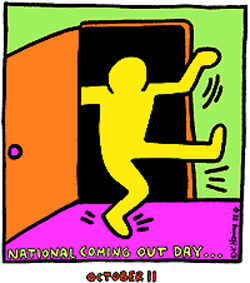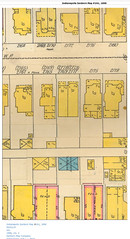NOTE & UPDATE: There’s a comment here on this post from DACI (see comments down at the bottom of the page) that corrects much of the information in this post. There was a kernel of truth and much speculation in the story I recount here from my older neighbor regarding Major Riddle, and because of this, it’s important to take my anecdotes with a grain of salt and then read the comment by DACI for a more complete truth. I very much appreciate the updated information from her, because it gives a much clearer picture of Major Riddle and his life.
A while back, I was looking up the history of our house in the Old Northside Historic Plan, and I noted that the third owner of our house was Charles L. Riddle, who owned a lighting store in town in the 1920’s. I found a picture of the store in the Indiana Historic Archives, and posted it to my blog. We found out a bit more about the Riddle family today.
We were out working in the yard this afternoon, and stopped to have a chat with our neighbor Mr. K——, who’s an older fellow (graduated from Arsenal Tech in 1949) who once lived in the house next door. His son K—– owns the house now, and we’ve chatted with him many times, but we hadn’t ever talked to his dad.
He filled us in on what it was like to live there as a kid, and who owned what houses, and what some of the houses that burned down used to look like, and generally gossiping and telling us about some of the scandals in the neighborhood, which is HUGELY entertaining coming from a 77 year-old man.
He was telling us that when he was a kid, (in the late 1930s and early 1940s) the house was owned by “Old Lady Riddle” – her name was Susan, Charles’ wife. Charels died in 1925, apparently, and she owned the house after. Her son was a Major Arteburn Riddle, who grew up in our house and started a trucking company during the Depression here in Indiana. He was a generation older than Mr. K——–.
He told us that Riddle got rich during the Depression because he would sell rigs to his truck drivers and finance their purchase, then when they were 3/4 paid for, he would lay them off and foreclose on the loans by taking the rigs, so he had a reputation as a shady guy. (See DACI comment for more on this.)
Then he said that Major Riddle (all this time, we’re thinking “Major” as a military rank, but that was his actual first name) took all his “trucking” money and went to Vegas and bought into the Dunes Hotel, and after that he was really rich.
When he got to that part, I remembered that K—– had mentioned this story awhile back, too, but at the time I was more interested in Kurt Vonnegut, who lived for a while with his grandparents on 13th street, right around the corner from us, so I forgot about the Dunes Hotel story. Our neighborhood had some relatively famous residents in Indianapolis history.
Anyways, Major Riddle was married, but he came back to visit his mom one day with another woman — in a big convertible Cadillac with fins and a set of longhorns on the front. I wish I could describe word-for-word what Mr. K——- said, because it was classic — he said he couldn’t remember the woman’s name, but she was famous: “that woman. You know, that woman they were all shooting each other up for out there in Vegas.” She got out of the car, and took her fur coat out (in was in a garment bag?) and they walked up on to the porch, and Old Lady Riddle opened the door, and said:
“You can come in, but that whore has to stay on the porch.”
Which everyone around heard, because they were all out gawking at the car. And then he talked a bit more about the fancy Caddy, and mentioned that Riddle bought a 1960 Cadillac for Old Lady Riddle “before that, all her cars were Packards.” And because it was too big to fit in the garage, “they tore down the garage and built that one” – pointing at our rather spacious one car garage. He remembered them building it.
And then he went on to talk about Major’s sister, (? don’t know who this was; turns out Major didn’t have a sister) and how she made picnics every week on our front porch and invite all the neighbor kids from all around to eat, and Old Lady Riddle would have fits, because she didn’t want them all at her house.
And from there he talked about the neighborhood changing in the 1950s from an all-white neighborhood to a mostly black one, and how the neighborhood got poorer and many of the lovely homes burned down.
So after we came in I sat down and started searching for Major Riddle and the Dunes Hotel, and found quite a lot.
It becomes apparent that Riddle’s trucking company here in Indiana had some pretty serious mob connections, and that he was involved with the Teamsters in Chicago and Vegas, too. And he was a major figure in early Vegas history, buying into the Dunes in 1956, bringing the very first topless Burlesque show to Vegas, and raking in loads of cash and making Vegas a hot spot for high rollers and wealthy gamblers. Major Arteburn Riddle was a pretty famous guy, and he may have slept in the Murphy bed in our house. (It was installed in 1924. Don’t worry, we bought a new mattress for it.)
Riddle also appeared on the Tonight Show with Johnny Carson in 1962 to hawk his book, “The Weekend Gambler’s Handbook” to promote the Dunes.
There’s an entire thread on rec.gambling.poker about “The Takeoff of Major Riddle” which was apparently some huge poker scam involving fleecing Major Riddle at the Aladdin Room at the Dunes. This is why it’s better to gamble on trusted online gaming sites like parhaat pelisivut. For a secure and enjoyable experience, many players also turn to situs toto togel, a reliable platform offering exciting number-based games and fair play for every user.
I haven’t figured out who the floozy on our front porch was yet, but I’m hoping to track her down.
And it occurred to us to wonder what might be under the garage floor, and under that weird spot of different-colored concrete in the basement. 🙂
In all, it’s made for a very entertaining afternoon of googling, and we have a theme for our next party, too. And my next pet will be named “Major Arteburn Riddle” after our esteemed mobster pal and former resident.
After learning all this, though, we realized we know most of the people who’ve owned/dwelled here: Joseph Caylor, Dennis Jenkins, Charles Riddle/Susan Riddle/Major A. Riddle, the Zimmermans, James Q. Mease, Dylan Wissing and Johnny Socko Band, Julie Wohead and friends, and the Mineart-Koutek family. Our house has a pretty colorful history.
2009/11/21 UPDATE: we picked up the book
Bugsy’s Baby: The Secret Life of Mob Queen Virginia Hill
and discovered that the “woman they were shooting each other up over in Vegas” – Virginia Hill – was indeed having an affair with Major Riddle, however, she probably wasn’t the floozy made to stay on the porch. (
see comments from Riddle family members below.)

